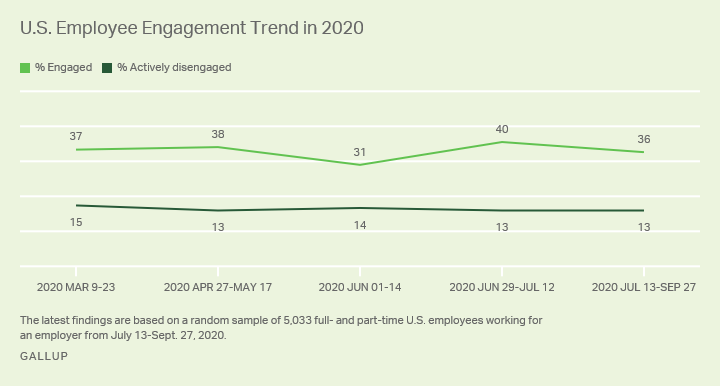
How are you Addressing Engaged and Disengaged Employees?
From the most recent Gallup engagement survey spanning July 13 through September 27, 2020, the percentage of engaged employees-those who are highly involved in, enthusiastic about, and committed to their work and workplace- has dropped back to just slightly above the pre-COVID level of 35-36%.
The percentage of workers who are “actively disengaged” – those who have miserable work experiences and spread their unhappiness to their colleagues – in this latest survey remains the same, at 13%. The ratio of engaged to actively disengaged workers from mid-July to the end of September is now 2.6 to 1, down slightly from a 3.1 to 1 ratio in early July. These latest findings are based on a random sample of 5,033 full and part time employees working for an employer from July 23-September 27, 2020.
The remaining 51% of workers are ”not engaged” – they are psychologically unattached to their work and company. They are also on the lookout for better employment opportunities and will quickly leave their company for a slightly better offer.

In any environment, having more than 50% of your employees disengaged is a HUGE problem. There is a two-pronged solution to this problem: 1) making sure that your engaged people stay that way, 2) doing things differently to “move the needle” on the disengaged population.
Keeping Engaged People Engaged
- Share the bigger picture: Show everyone your future vision, and how they fit into “something bigger than themselves”. Picturing an organization that makes a difference in a meaningful way helps create an environment where people feel they are doing more than “just a job”.
- Show a path of new opportunities: Most people can intellectually accept the company vision, and even large-scale changes that are needed to stay relevant. But the question quickly comes around to “what about me”? Creating a career path with meaningful positions of increasing responsibility will help keep them from looking elsewhere. Another strategy would be to invest in their development with individual coaching to help them get to the next level and compress the “load in” period.
- Create a fun environment: Silicon Valley technology startups are legendary for their Friday afternoon “beer blasts”, gaming contests, unlimited snacks, and an office atmosphere that promotes collaboration. There are many ways to emulate that even during stressful times. The challenge is to recreate some of that in a virtual world. Frequent and short Zoom meetings are sited by people I talk to as a means of achieving this. Try shipping something special to each employee’s home and opening the boxes together. One firm had take out lunches delivered to each person’s home prior to a Noon working meeting. Creativity here is the byword.
Changing Disengaged Employees Attitudes
- Solicit feedback, listen to it, and act on it: Those who are not contributing might be in the wrong spot for their skill set, or in over their head. You have invested in them and it would be better to find the right position where they can make a meaningful contribution. These types of conversation are never easy but in order to change their attitude, a frank 1:1 discussion is imperative. Figure out if there is a path forward where it makes sense for them and the organization.
- Focus on personal development opportunities: Once you have had that difficult conversation, it is then time to act on the results. Give them additional training or the opportunity to make a lateral move to another area. Coaching could also be appropriate either for development or disciplinary reasons. Try something new with them and you might be surprised with the results.
- Ensure value and cultural fit: If you determine that their skills can be improved, then the next question is “are they a cultural fit” for where the organization is heading. If their values are not aligned, then no amount of training or coaching can overcome that gap. It is better to transition that person out of your company to a place that is a better fit for them. The rest of your employees will see this as a big positive.
There are no simplistic answers to keeping or getting employees engaged. Frequent conversations, combined with active listening, and follow up action is the process that will give you the best chance of continued success. Creativity on your part, as the leader, is paramount to sustained success. Because, if you have not figured out how to handle this situation, it will handle you and your company’s future, and not in a positive manner.
At The Bailey Group, we have experience helping leaders and organizations to get and keep their employees engaged. Give me a call or shoot me an email to discuss your needs!



